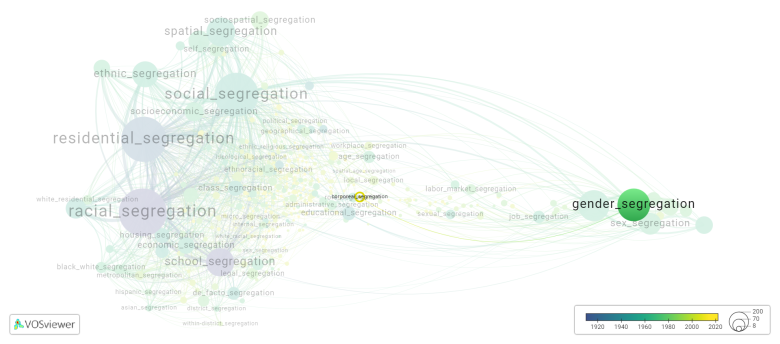Corporeal segregation: Difference between revisions
(Creating page) |
(Creating page) |
||
| (10 intermediate revisions by the same user not shown) | |||
| Line 1: | Line 1: | ||
===== Date and country of first publication<ref>Date and country of first publication as informed by the Scopus database (December 2023).</ref>===== | |||
2018<br> | 2018<br> | ||
Portugal | |||
===== Definition ===== | |||
Corporeal segregation refers to the physical separation or division of individuals based on specific physical characteristics, such as race or ethnicity, within a society or community. | Corporeal segregation refers to the physical separation or division of individuals based on specific physical characteristics, such as race or ethnicity, within a society or community. | ||
| Line 10: | Line 12: | ||
While corporeal segregation is now largely illegal in many countries and highly discouraged, the legacy of past segregation policies and practices can still be seen today in the form of socioeconomic and spatial inequalities. Efforts towards desegregation and promoting inclusivity have been ongoing, but the challenges and consequences of corporeal segregation continue to be significant social issues. | While corporeal segregation is now largely illegal in many countries and highly discouraged, the legacy of past segregation policies and practices can still be seen today in the form of socioeconomic and spatial inequalities. Efforts towards desegregation and promoting inclusivity have been ongoing, but the challenges and consequences of corporeal segregation continue to be significant social issues. | ||
==See also== | ==See also== | ||
==Related segregation forms== | |||
Corporeal segregation is frequently discussed in the literature with the following segregation forms: | |||
[[gender segregation]] | |||
[[File:corporeal_segregation.png|780x780px]] | |||
This visualization is based on the study [[Segregation_Wiki:About| The Multidisciplinary Landscape of Segregation Research]]. | |||
For the complete network of interrelated segregation forms, please refer to: | |||
* [https://tinyurl.com/2235lkhw First year of publication] | |||
* [https://tinyurl.com/2d8wg5n3 Louvain clusters] | |||
* [https://tinyurl.com/223udk5r Betweenness centrality] | |||
* [https://tinyurl.com/244d8unz Disciplines in which segregation forms first emerged (Scopus database).] | |||
==References== | ==References== | ||
== | ==Notes== | ||
<references /> | |||
{{NoteAI}} | |||
==Corporeal segregation appears in the following literature== | |||
Canlı E. (2018) | Canlı E. (2018). Binary by Design: Unfolding Corporeal Segregation at the Intersection of Gender, Identity and Materiality. ''Design Journal'', ''21''(5), 651-669. Taylor and Francis Ltd..https://doi.org/10.1080/14606925.2018.1491716 | ||
Latest revision as of 07:17, 16 October 2024
Date and country of first publication[1][edit | edit source]
2018
Portugal
Definition[edit | edit source]
Corporeal segregation refers to the physical separation or division of individuals based on specific physical characteristics, such as race or ethnicity, within a society or community.
This type of segregation involves the establishment of physical boundaries or restrictions that relegate certain groups to specific areas or locations, effectively preventing them from freely integrating or interacting with other groups. These boundaries can manifest in various forms, such as residential areas, public facilities, schools, or even entire towns or cities.
Corporeal segregation has historically been associated with oppression and discrimination, often perpetuating social, economic, and political disparities between different groups. It has been prevalent in many societies throughout history, including apartheid-era South Africa and racially segregated America.
While corporeal segregation is now largely illegal in many countries and highly discouraged, the legacy of past segregation policies and practices can still be seen today in the form of socioeconomic and spatial inequalities. Efforts towards desegregation and promoting inclusivity have been ongoing, but the challenges and consequences of corporeal segregation continue to be significant social issues.
See also[edit | edit source]
Related segregation forms[edit | edit source]
Corporeal segregation is frequently discussed in the literature with the following segregation forms:
This visualization is based on the study The Multidisciplinary Landscape of Segregation Research.
For the complete network of interrelated segregation forms, please refer to:
References[edit | edit source]
Notes[edit | edit source]
- ↑ Date and country of first publication as informed by the Scopus database (December 2023).
At its current state, this definition has been generated by a Large Language Model (LLM) so far without review by an independent researcher or a member of the curating team of segregation experts that keep the Segregation Wiki online. While we strive for accuracy, we cannot guarantee its reliability, completeness and timeliness. Please use this content with caution and verify information as needed. Also, feel free to improve on the definition as you see fit, including the use of references and other informational resources. We value your input in enhancing the quality and accuracy of the definitions of segregation forms collectively offered in the Segregation Wiki ©.
Corporeal segregation appears in the following literature[edit | edit source]
Canlı E. (2018). Binary by Design: Unfolding Corporeal Segregation at the Intersection of Gender, Identity and Materiality. Design Journal, 21(5), 651-669. Taylor and Francis Ltd..https://doi.org/10.1080/14606925.2018.1491716

